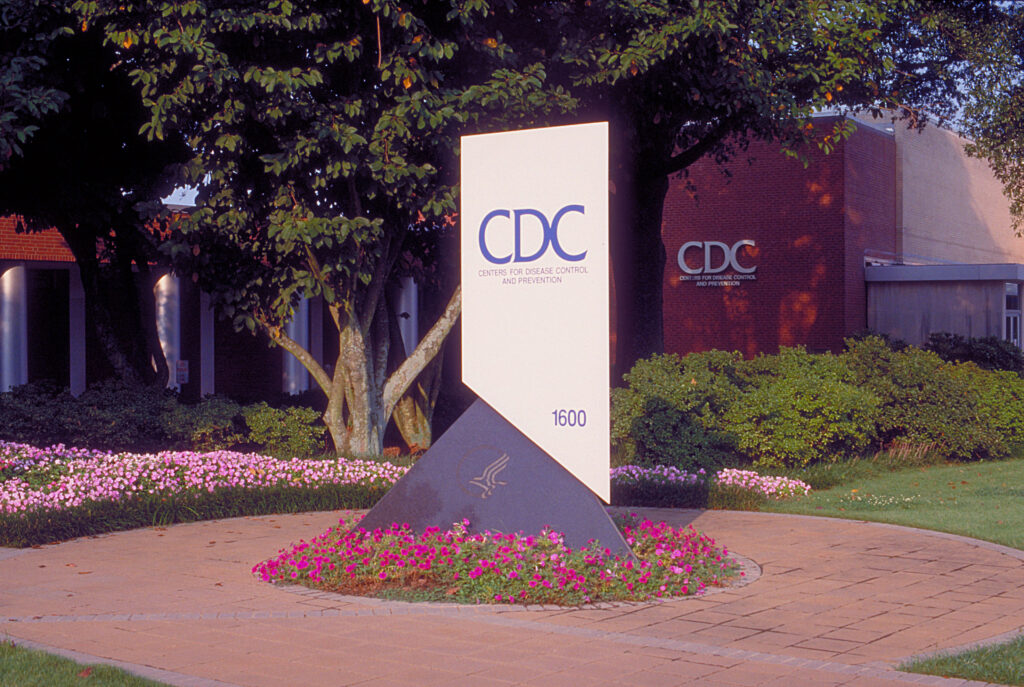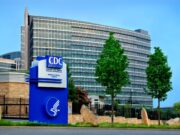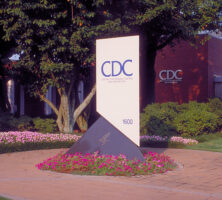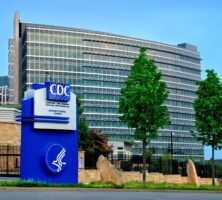The Centers for Disease Control and Prevention (CDC), with headquarters in Atlanta, has been a key factor in combating many of the health issues facing the United States. It is the nation’s premier public health agency, and a unit of the U.S. Department of Health and Human Services.
The Early Years
After World War II (1941-45), Joseph W. Mountin, a physician and public health leader, formed a plan to convert the Malaria Control in War Areas (MCWA) office to a peacetime agency to monitor and control infectious diseases. CDC was organized as the Communicable Disease Center on July 1, 1946, in Atlanta. Mountin had high hopes for the new institution, which was part of the U.S. Public Health Service. Administrators and directors who have served since the agency’s inception include Raymond A. Vonderlehr (1947-51), Justin M. Andrews (1952-53), Theodore J. Bauer (1953-56), Robert J. Anderson (1956-60), Clarence A. Smith (1960-62), James L. Goddard (1962-66), David J. Sencer (1966-77), William H. Foege (1977-83), James O. Mason (1983-89), William L. Roper (1990-93), David Satcher (1993-98), Jeffrey P. Koplan (1998-2002), Julie L. Gerberding (2002-9), interim director Richard E. Besser (2009), Thomas Frieden (2009-2017), Brenda Fitzgerald (2017-2018), and Robert Redfield (2018- ).
CDC originally had fewer than 400 employees, who were housed in the old MCWA offices in downtown Atlanta. Most of the scientists were entomologists and engineers who had worked for MCWA, which during the war had controlled the spread of malaria in the southeastern states, where most of the U.S. basic military training was done. CDC was established to serve all states and eventually expanded to include all communicable diseases. Over time, CDC became known as a center for training among public health professionals around the world.

In 1949 Dr. Alexander Langmuir came to CDC to head the epidemiology branch. Soon afterward he launched the disease surveillance program to collect, analyze, and disseminate disease data to public health practitioners. The disease surveillance program became an integral part of public health practice and the basis on which CDC’s mission of service to the states was built. In 1951, after the Korean War (1950-53) began, the Epidemic Intelligence Service was created as a two-year postdoctoral program that combined training in epidemiology with service to the states. The threat of biological warfare caused Langmuir to train epidemiologists to watch for intentional threats in addition to protecting the public against natural health threats.

The young agency struggled to survive. Emory University gave CDC land on Clifton Road in 1947 to build its headquarters, but construction did not begin for another decade. Two major health crises in the mid-1950s helped CDC establish its credibility. When poliomyelitis appeared in children after they received contaminated Salk vaccines, CDC helped to identify the problem and correct it. When the United States was faced with a massive influenza epidemic, CDC gathered data and developed the national guidelines for an influenza vaccine. Other programs that helped CDC grow included the addition of the venereal disease program in 1957, the tuberculosis program in 1960, immunization practices and the Morbidity and Mortality Weekly Report in 1961, and the Foreign Quarantine Service in 1967.

In addition to new responsibilities, CDC was intimately involved in one of the greatest achievements in public health: the eradication of smallpox. In 1962 CDC established the smallpox surveillance unit and tested the newly developed jet gun and vaccine. The agency refined mass vaccination techniques and used a “surveillance and containment” strategy to effect eradication. Under the auspices of the World Health Organization global team, which included hundreds of CDC staff, the smallpox virus was eliminated globally by 1977.
An Expanding Mission
In the 1970s, in addition to new responsibilities in communicable diseases such as measles and rubella vaccination programs, CDC added programs in nutrition, family planning, chronic diseases, and birth defects. The National Institute for Occupational Safety and Health also joined CDC. In 1970 the agency was renamed the Center for Disease Control to reflect its expanding role in public health. Participation in nutrition and family planning activities in other parts of the world, as well as increased efforts to control infectious diseases such as malaria, marked an expanded role in international health. CDC was even given responsibility for protecting the earth from moon “germs” as astronauts returned from the Apollo space flights.
Despite all its early achievements, CDC has also been criticized. It faced detractors in 1976, when some recipients of a vaccine to protect the U.S. population against swine flu developed Guillain-Barre syndrome, a neurological disease that causes paralysis. Both the Public Health Service (PHS) and CDC were faulted for the Tuskegee study (1932-72), which examined the long-term effects of untreated syphilis in Black men. PHS and CDC representatives were on hand when U.S. president Bill Clinton formally apologized to the Tuskegee survivors in May 1997.
Regardless of the criticism, CDC persevered in its efforts to improve public health. In the 1970s CDC identified the Ebola virus and the sexual transmission of the hepatitis B virus, and isolated the hepatitis C virus and the bacterium that causes Legionnaires’ disease. CDC scientists also conducted a study that proved for the first time the effectiveness of recommended infection-control practices in hospitals.
During the 1980s CDC laboratory scientists and epidemiologists collaborated on the identification of toxic shock syndrome (TSS). They documented the association of TSS with a particular brand of tampon, which was subsequently removed from the market. A similar collaboration between laboratory scientists and the National Center for Environmental Health, as well as statisticians with the National Center for Health Statistics, resulted in the removal of lead from gasoline. Another major endeavor during this decade was CDC’s work on the AIDS epidemic. Other significant research of the 1980s included studies of the relationship of cancer in women and the use of steroid hormones, and studies of the adverse health effects of the Vietnam War (1964-73) on veterans and their offspring. This decade was also significant because CDC added more activities in scientifically based rapid assessment, disaster assistance, public health surveillance, and occupational public health.
In the 1990s more emphasis was placed on prevention, and the agency responded more often to global problems. The National Immunization Program was established in this decade; it included significant funding for the Vaccine for Children Program. A major CDC contribution to world health was leadership in global polio eradication. By 1992 CDC had expanded far beyond communicable diseases, and the agency’s name was changed to the Centers for Disease Control and Prevention. (The acronym remained CDC by law.)

Coordinating and National Centers
Each of CDC’s coordinating centers/offices implements CDC’s response in their areas of expertise while also providing intra-agency support and resource-sharing for cross-cutting issues and specific health threats.
1) The Office of the Director manages and directs the activities of CDC; provides overall direction to, and coordination of, the scientific/medical programs of CDC; and provides leadership, coordination, and assessment of administrative management activities.
2) The Coordinating Center for Environmental Health and Injury Prevention plans, directs, and coordinates national and global public health research, programs, and laboratory sciences that improve health and eliminate illness, disability, and/or death caused by injuries or environmental exposures. It includes the following programs:
• The National Center for Environmental Health provides national leadership in preventing and controlling disease and death resulting from the interactions between people and their environment.
• The Agency for Toxic Substances and Disease Registry (ATSDR) is a sister agency of CDC and one of eight federal public health agencies within the U.S. Department of Health and Human Services. CDC performs many of the administrative functions for the ATSDR, and the director of CDC also serves as the administrator of the ATSDR.
• The National Center for Injury Prevention and Control deals with nonoccupational injuries, including those that are unintentional and those that result from violence.
3) The Coordinating Center for Health Information and Service provides leadership and promotes innovation in public health informatics, health statistics, health marketing, and scientific communications. It includes the following programs:
• The National Center for Health Statistics provides statistical information to guide actions and policies to improve the health of the American people.
• The National Center for Public Health Informatics provides national leadership in the application of information technology in the pursuit of public health.
• The National Center for Health Marketing provides national leadership in health marketing science and in its application to impact public health.
4) The Coordinating Center for Health Promotion plans, directs, and coordinates a national program for the prevention of prematurity, mortality, morbidity, and disability due to chronic diseases, genomics, disabilities (physical and developmental), birth defects, reproductive outcomes, and adverse consequences of hereditary conditions, including blood disorders. It includes the following programs:
• The National Center on Birth Defects and Developmental Disabilities provides national leadership for preventing birth defects and developmental disabilities and for improving the health and wellness of people with disabilities.
• The National Center for Chronic Disease Prevention and Health Promotion prevents premature death and disability from chronic diseases and promotes healthy personal behaviors.
• The Office of Public Health Genomics provides national leadership in fostering understanding of human genomic discoveries and how they can be used to improve health and prevent disease.
5) The Coordinating Center for Infectious Diseases protects health and enhances the potential for full, satisfying, and productive living across the lifespan of all people in all communities related to infectious diseases. It includes the following programs:
• The National Center for HIV/AIDS, Viral Hepatitis, STD, and TB Prevention integrates epidemiology, laboratory science, and intervention and prevention initiatives related to a broad range of sexually transmitted diseases to enhance opportunities to develop and implement collaborative public health interventions with shared at-risk populations.
• The National Center for Immunization and Respiratory Diseases, an interdisciplinary immunization program, brings together vaccine-preventable disease science and research with immunization program activities.
• The National Center for Zoonotic, Vector-Borne, and Enteric Diseases provides national and international scientific and programmatic leadership addressing zoonotic, vector-borne, foodborne, waterborne, mycotic, and related infections to identify, investigate, diagnose, treat, and prevent these diseases.
• The National Center for Preparedness, Detection, and Control of Infectious Diseases focuses on improving preparedness and response capacity for new and complex infectious disease outbreaks; manages and coordinates emerging infectious diseases; integrates laboratory groups; and facilitates increased quality and capacity in clinical laboratories.
6) The Coordinating Office for Global Health provides national leadership, coordination, and support for CDC’s global health activities in collaboration with CDC’s global health partners.
7) The Coordinating Office for Terrorism Preparedness & Emergency Response helps the nation prepare for and respond to urgent public health threats by providing strategic direction, coordination, and support for all of CDC’s terrorism preparedness and emergency response activities.
8) The National Institute for Occupational Safety and Health ensures safety and health for all people in the workplace through research and prevention.
Current Focus
CDC has created a special exhibition area at its Atlanta headquarters, the David J. Sencer CDC Museum (fomerly the Global Health Odyssey Museum). The museum serves to welcome and orient visitors to CDC and to show why the agency’s work is important. It informs visitors about the history of public health in America, shows them how CDC’s efforts reach into their daily lives, and increases their awareness of the role of the individual in preventing disease, injury, and death.
CDC has responded to public health emergencies for decades and has prepared for the threat of terrorism in particular since 1998. CDC’s terrorism plans were put into action in fall 2001, after the September 11 attacks on the World Trade Center in New York and the Pentagon in Washington, D.C., and the subsequent intentional distribution of anthrax through the mail. The anthrax attack proved that the first line of defense is rapid identification—essential for ensuring a prompt response to a biological or chemical attack so that exposure can be limited and those affected can be treated. After the anthrax attack, regional and state laboratories strengthened their capacity to detect biological and chemical agents and to communicate the results to CDC and others. Along the same lines, CDC’s Health Alert Network has upgraded the capacity of state and local health agencies to communicate different health threats—including bioterrorism, emerging infectious diseases, chronic diseases, and environmental hazards.
CDC has worked with pharmaceutical companies and other partners to create regional stockpiles of the drugs, vaccines, and other supplies that would be needed quickly to respond to intentional outbreaks of anthrax, plague, tularemia, or other diseases potentially caused by terrorist attacks. These resources were essential in responding to the terrorist attacks of September 11, 2001, as well as to the anthrax attack. Collectively, these measures strengthen the existing public health system. Today, CDC is both the nation’s prevention agency and a global leader in public health. CDC remains committed to achieving its vision of healthy people in a healthy world through prevention.














